| The Seasons | |
|---|---|
| Artist | Alphonse Mucha |
| Year | 1896, 1897, 1900 |
| Medium | Color lithograph |
The Seasons or Four Seasons is the name of three different color lithograph series produced by Czech visual artist Alphonse Mucha. They were produced in 1896, 1897, and 1900.
Background
In 1895, Mucha produced the poster for Gismonda, a play starring Sarah Bernhardt. Bernhardt highly admired Mucha's work, commissioning a six-year contract with him.[1] The style employed in Gismonda, le style Mucha, became a sensation in Paris and became known as the Art Nouveau movement.[2]
Following Gismonda, Mucha attained an influx of work. He was shortly thereafter commissioned by F. Champenois, a wealthy patron and Paris-based printer.[1] While working with Champenois, Mucha created decorative panels, or posters with text that were solely for decoration.[3] These panels were published in large print runs.
Composition and prints
Mucha's Seasons series were emblematic of his graphic works, which featured strong centered compositions and idealized and allegorical female figures in sensuous or provocative poses.[4][5] Mucha's panels also bear some resemblance to Japanese woodcuts. Indeed, Mucha was influenced by Japanese art, like many other 19th- and 20th-century European artists.[6]
The female figures in Mucha's works were "entwined in vaporous hair and light dresses inspired by nature, such as willowy foliage," as well as adorned in extravagant jewels.[4][5] Mucha fills the background of these pieces with floral or abstract patterns.[4] Natural colors and gold also help accentuate the pieces, while functional and decorative friezes often frame Mucha's illustrations.[4] The prints of his Four Seasons series would become scarce.[7]
1896 series
The Seasons, published in 1896, served as the first series Mucha produced during his time with Champenois.[1] The Seasons depicted four different women in floral settings representing the seasons of the year: Winter, Spring, Summer, and Autumn.[8] Each panel was sized 103 × 54 cm.[9]
Each of the seasons has a characteristic flair to their allegorical depictions. Spring, Summer, Autumn, and Winter are portrayed as innocent, sultry, fruitful, and frosty, respectively.[10]
Summer is adorned with red poppies in her hair, the figure is seen leaning on a grapevine and bathing her feet in shallow water. Autumn is depicted as a wearing a wreath of chrysanthemums in her brunette hair. She is also seen gathering grapes from a vine. Mucha represents Spring as a blonde figure in a translucent white dress standing under a tree and holding a lyre. Meanwhile, Winter is depicted as a figure draped in a pale green cape and sheltering from the cold, standing next to a snow-capped bush.
 Spring (1896)
Spring (1896)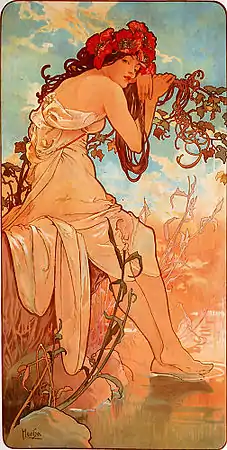 Summer (1896)
Summer (1896) Autumn (1896)
Autumn (1896) Winter (1896)
Winter (1896)
1897 and 1900 series
Due to the success of the 1896 series, Champenois asked Mucha to design to more sets based on the seasonal theme in 1897 and 1900.[1][11] Designs for another two sets also exist.[1]
The 1897 series of color lithographs on paper featured 150 × 430 mm panels and is located at the Art Institute of Chicago.[12]
The 1900 series also features color lithographs, this time sized 54.29 cm × 75.88cm.[13] The 1900 series is located at the Victoria & Albert Museum.[13]
 Spring (1897)
Spring (1897)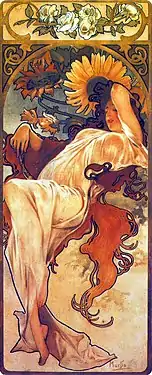 Summer (1897)
Summer (1897)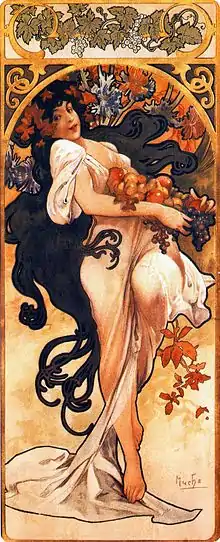 Autumn (1897)
Autumn (1897)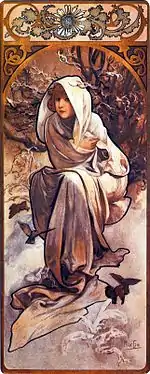 Winter (1897)
Winter (1897)
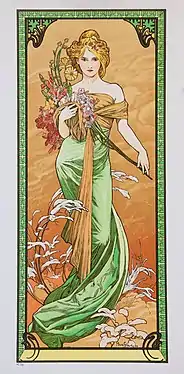 Spring (1900)
Spring (1900)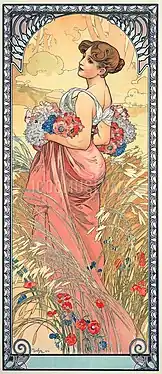 Summer (1900)
Summer (1900)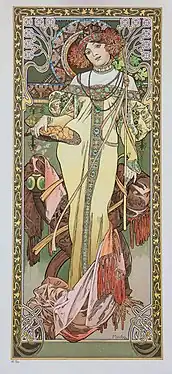 Autumn (1900)
Autumn (1900)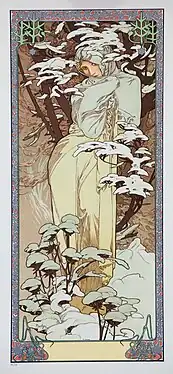 Winter (1900)
Winter (1900)
References
- 1 2 3 4 5 "Daily art story: Mucha's Seasons". Museums of the World. 4 February 2015. Retrieved 27 September 2022.
- ↑ "Alphonse Mucha: Art Nouveau Visionary". North Carolina Museum of Art. Retrieved 27 September 2022.
- ↑ Kern 1980, p. 72.
- 1 2 3 4 "Four Seasons MUCHA, Alphonse". Web Gallery of Art. Retrieved 27 September 2022.
- 1 2 Ulmer 1994, p. 12–13.
- ↑ Ulmer 1994, p. 9.
- ↑ Rogers 1899, p. 58.
- ↑ "The Seasons (series) (1896)". Mucha Foundation. Retrieved 27 September 2022.
- ↑ Tsaneva, Maria (14 January 2014). Alfons Mucha: 131 Posters and Paintings. Lulu.com. ISBN 9781304804686. Retrieved 27 September 2022.
- ↑ Wilson, Anne (5 June 2013). "Distinguished Collection of Alphonse Mucha Lithographs on Offer at Bonhams New York". Art Fix Daily. Retrieved 27 September 2022.
- ↑ "The Seasons (series) (1900)". Mucha Foundation. Retrieved 27 September 2022.
- ↑ "The Seasons". Art Institute of Chicago. Retrieved 27 September 2022.
- 1 2 "The Seasons". Victoria & Albert Museum. 30 June 2009. Retrieved 27 September 2022.
- Sources
- Kern, David M. H., ed. (October 1980). The Art Nouveau Style Book of Alphonse Mucha. Dover Publications. ISBN 9780486240442. Retrieved 27 September 2022.
- Rogers, W. S. (October 1899). Hiatt, Charles; Woestyn, H.-R; MacLaey, Hugh (eds.). The Poster and Art Collector. Vol. 3. University of California, Berkeley. Retrieved 27 September 2022.
- Ulmer, Renate (1994). Alfons Mucha. Taschen. ISBN 9783822885741.
Further reading
- Mucha, Jiří (1989). "Alphonse Maria Mucha: His Life and Art". Random House. pp. 107, 121–122. Retrieved 27 September 2022.
- Sato, Tomoko (2016). Alphonse Mucha. Skira. ISBN 9788857232430.
- Warren, Richard; Fögen, Thorsten, eds. (24 May 2016). Graeco-Roman Antiquity and the Idea of Nationalism in the 19th Century. De Gruyter. p. 244. ISBN 9783110473490. Retrieved 27 September 2022.